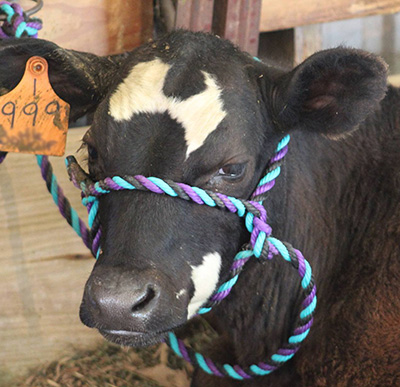County fair purchase supports youth exhibitors and provides beef for you
7/11/24

AMES, Iowa — County fair season in Iowa is officially upon us. Young exhibitors have put in many hard hours to prepare for this week. One way to show support is by purchasing a market animal at the local county livestock auction or directly from a 4-H or FFA member. However, choosing to buy an animal this way is just the first in a number of decisions you'll need to make.
Iowa State University extension program specialist Beth Reynolds offers these considerations.
What do I get when I purchase 4-H beef?
Some counties can send animals to the packer, where you would not receive any meat, but many opt to send the animal to a local locker to be processed and fill the freezer. In that case, you must contact the locker to tell them how you would like your animal processed. Some basic knowledge about processing can make this step less daunting.
While processing costs often are based on carcass weight, the carcass weight is not the same as the live weight.
Dressing percentage is the weight after the head, hide, and internal organs have been removed, divided by the live weight. The dressing percentage differs from the retail meat yield because it still includes bones and fat. A 1,400-pound steer typically has a dressing percentage between 60-64%.
Retail meat yield, or how many pounds will need to be put in the freezer, is influenced by various factors. Generally, assume a 1,400-pound steer with a dressing percentage of 61% should yield about 572 pounds of meat. Keep in mind that every animal is different, and these are approximations.
What cuts are available?
The carcass is split into eight primal cuts: chuck (27%), shank (3%), rib (10%), loin (17%), brisket (4%), short plate (8%), flank (5%), and round (22%). These primal cuts are then split into the retail cuts you choose. The best part about processing locally is you can decide exactly how you want to split the primal cuts. Everything can be cut into steaks or whole cuts, or it can all be turned into ground beef, or anything in between depending on your preferences. You'll work with your local processor to make these decisions.
How can local processing save money?
When buying at retail like a grocery store, you are subjected to changing prices every time you want to purchase more beef. When processing locally, you pay the locker a processing rate plus what you paid for the animal. Another option to lower the upfront cost is to split the beef with family and friends. Instead of keeping all the meat, it can be divided into halves or quarters, and each order can be customized to the desired cuts of the purchaser.
Purchasing beef from a 4-H or FFA member at a county fair is not just a transaction, it's a meaningful way to support local youth and acquire high-quality meat at the same time. This tradition fosters community involvement and ensures consumers receive locally sourced beef tailored to their preferences.
The "How Much Meat To Expect From A Beef Carcass" publication from the University of Tennessee provides more detail on the breakdown of a beef carcass in terms of weight, carcass and primal cuts, and factors affecting yield of retail cuts. It's available free of charge.
(This article was written by IBC communications intern Dacia Schoulte.)
-30-
The Iowa Beef Center at Iowa State University was established in 1996 with the goal of supporting the growth and vitality of the state’s beef cattle industry. It comprises faculty and staff from Iowa State University Extension and Outreach, College of Agriculture and Life Sciences and College of Veterinary Medicine, and works to develop and deliver the latest research-based information regarding the beef cattle industry. For more information about IBC, visit www.iowabeefcenter.org.
Contact:
Beth Reynolds, ISU Extension and Outreach program specialist, 515-294-9881, bethr@iastate.edu
